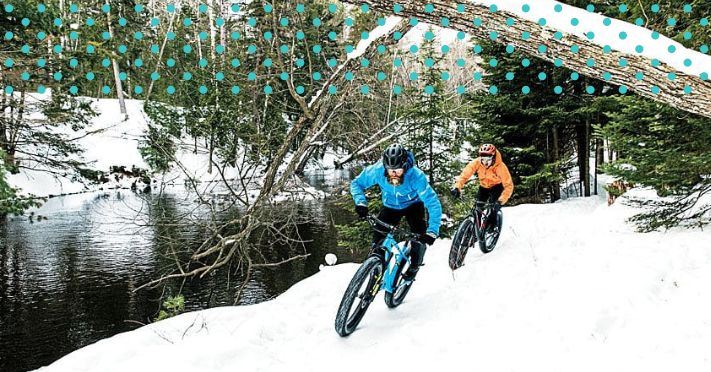
Travis Brown knows how to ride bikes, and he knows how to ride them even when the mercury drops. He’s a Mountain Bike Hall of Famer who was inducted in 2006 for his long career as a cross-country racer. He’s best known for his strong finishes during his tenure as a racer for Trek, a partnership that started in 1993 when Travis joined the Trek/ Volkswagen team and still continues today. He’s racked up two Single Speed World Championship titles, as well as many top finishes at UCI and NORBA races. He was also selected to represent the USA at the 2000 Olympic Games.
Born and raised in the Colorado mountains in Durango and working with a company based in Waterloo, Wisconsin, he’s no stranger to long winters and cold-weather rides. Heck, where he lives, if you’re unwilling to ride in the cold, you’ll not ride for much of the year. So any advice he has on how to ride in cold conditions needs to be listened to.
Travis Brown’s Cold Weather Riding Tips
We were fortunate enough to chat with Travis about his favorite tips for riders who aren’t afraid to venture out into the cold to keep their pedals moving. These are his best tips to keep you from abandoning your bike until the spring thaw.
Keep the Blood Moving
Good blood circulation and layering are key strategies for staying comfortable and warm when riding in colder temperatures, especially for the extremities. Hands and feet are the hardest things to keep warm. I use gloves a size larger than normal to allow good circulation and to have the option of adding a thin thermal liner.
Stay Away from Metal Components
Carbon bars, foam grips with no metal lock collars, and carbon levers draw less heat out of your hands. These will keep your hands warmer whether or not you ride with winter gloves.
Go Bigger
I size up one or even two sizes with shoes to make room for an additional insole/footbed for insulation, thicker socks, or sock layering while still having space for good circulation. Insulation from the cleat is critical. Your foot is only a few millimeters away from the cleat that is attached to a metal pedal and crank sitting out in the cold wind. This is a big thermal sink attached to your foot.

Buy A Winter-Specific Pedal And Shoe Setup
Investing in a winter-specific riding shoe is well worth the money if you plan to pedal through the cold months. Also, flat pedals are best for colder conditions because of the ability to use shoes with more insulation under your foot. Find a shoe and pedal pair that work well together, and plan to use them during the winter months.
Keep ’Em Toasty With Mini Heaters
I have also had good luck with disposable, adhesive foot warmers for really cold conditions. Skiers use the same ones in their boots, which activate when you open them and expose the chemicals to air. Most outdoor sporting goods stores sell these and work best with the slightly bigger shoe setup.
When It’s Cold – But Not That Cold
Simply taping over your shoe’s toe vents helps for moderately cold conditions. This prevents the airflow from hitting your toes. Use duct or Gorilla tape, as it’s sticky and water-resistant. Just be sure not to leave it on too long, as it can leave a nasty residue that’s hard to get off.

Flip On The Heater
Your head and neck are your body’s radiators. Adding and subtracting layers here is a quick and efficient way to manage body temperature. I like to use a balaclava to cover my nose and cheeks for a quick and easy way to keep the temps up.
Change Your Eye Protection
In the coldest temperatures, consider goggles rather than glasses. They prevent your eyes from watering much better and limit airflow. Your vision will improve and your face will be warmer.
The Bearded Rider
Grow a beard if you can. It will keep your face warmer — really.
Keep It Dry
Moisture management is another key to maintaining body heat on longer rides in the cold. If it is below freezing and you won’t get rained on, barrier layers will hold in too much perspiration. You are better off adding additional breathable thermal layers if you plan to be sweating. If barrier layers are a must, being conservative about how much you sweat is important. Also, limit your exposure time. It is very difficult to stay warm once you are wet.
Keep It Layered
Quality base layers that are form-fitting and have good wicking properties will definitely extend your comfort window in cold conditions. The worst thing you could wear would be a low-tech layer like a cotton t-shirt or sweatshirt. Instead, go for synthetic fabrics or wool, as they tend to keep the moisture away from your skin better.

Try Plus-Size or Fat Tires
That little bit of extra wheel weight carries itself much better than a standard-size tire when it’s on snow. The bigger air volume floats above snow and ice and also provides better traction thanks to the increased surface area. Since plus-size and fat bikes have caught on in a serious way, there are plenty of new options to try when it comes to tire choices too.
Hit The Trails In All Weather Conditions
A little bit of cold weather, snow, or rain needn’t impact your ability to get out on the road or trail and enjoy your e-bike to your heart’s content. Travis’ advice will help you ride safely in all conditions and maximize your riding experience.
Ready to hit the trails in all conditions? Read our guide on how to ride an electric bike safely and discover how to ride your bike safely in the rain.

